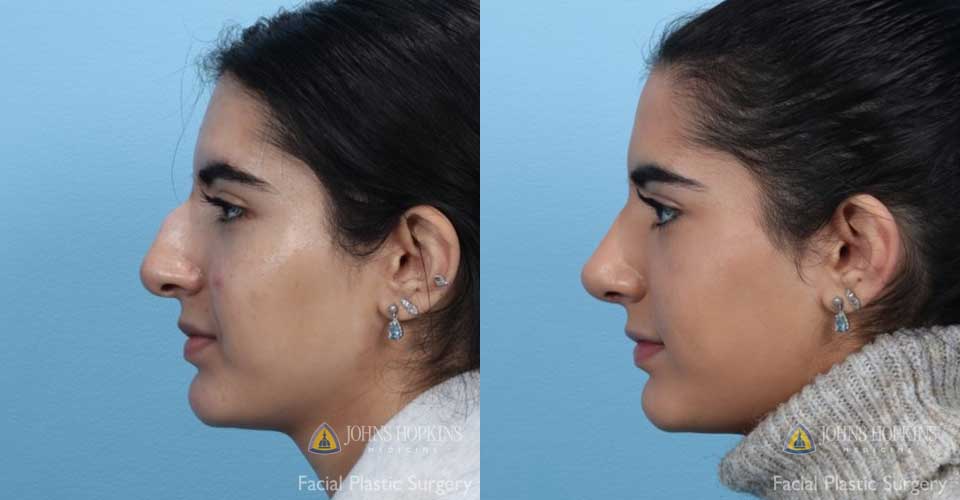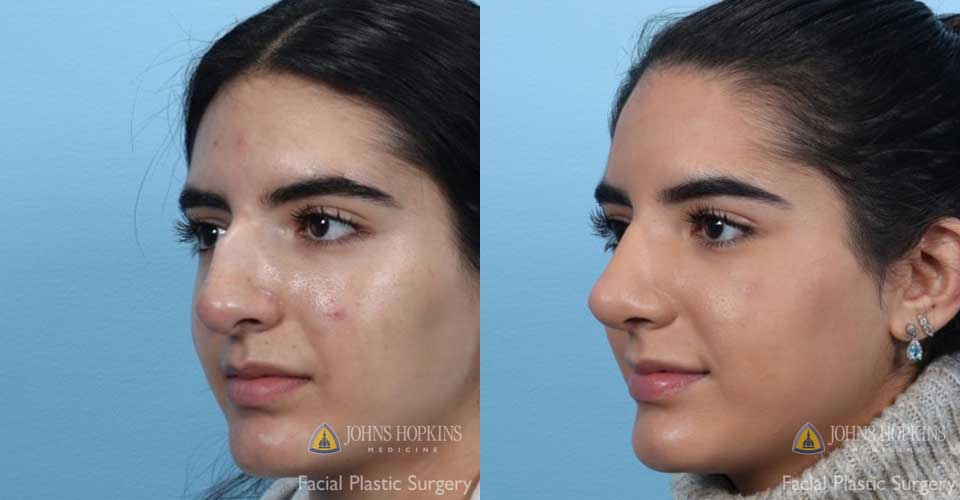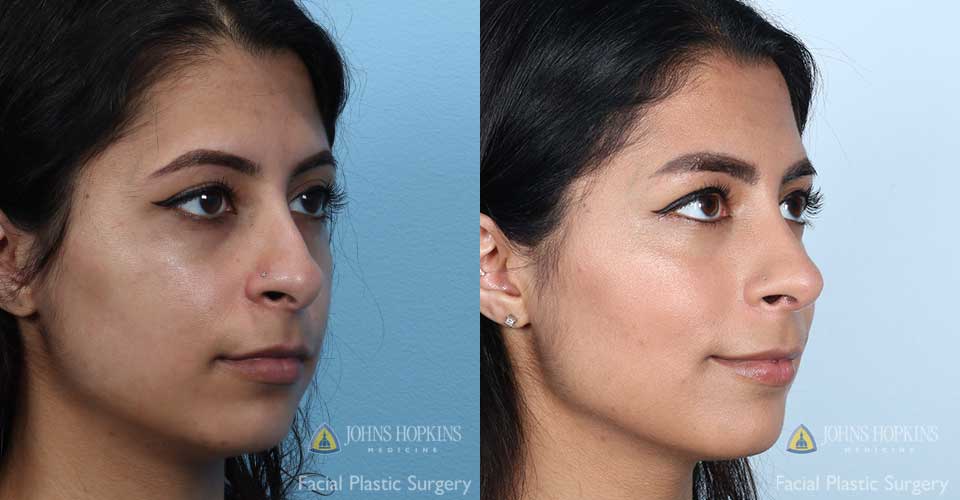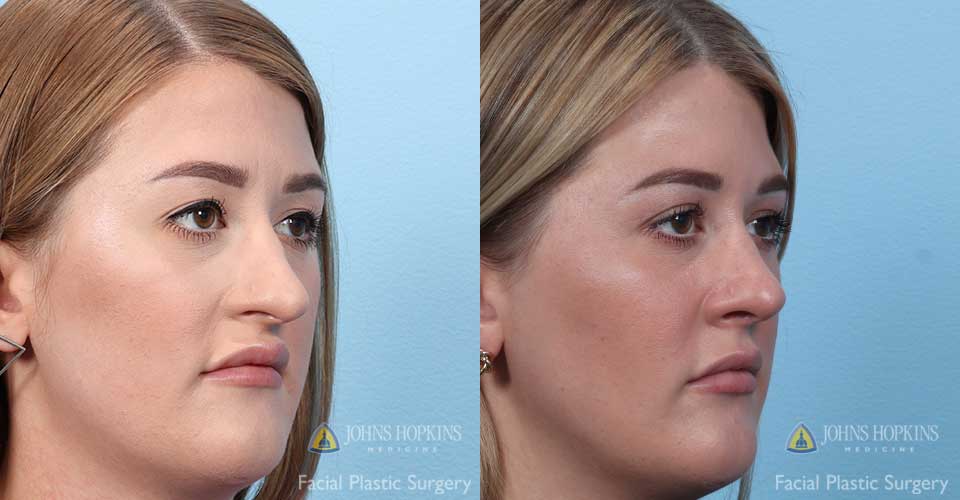Rhinoplasty is a cosmetic procedure to change the size or shape of the nose to achieve more balance and symmetry of the facial features and improve appearance. A rhinoplasty can also be simultaneously performed with procedures to improve the function of the nose by correcting obstructed breathing.
Learn more about:
Our Team | What to Expect | Before and After Photos | Ethnic Rhinoplasty | Educational Videos
Request An Appointment
Schedule by phone
New and existing patients: 443-997-6467
Submit a request online
You may also request an appointment by filling out this form.
Why Choose Johns Hopkins for Rhinoplasty
Choosing the right specialist is very important in rhinoplasty. This procedure is considered by many to be the most complex and delicate plastic surgery operation, requiring surgeons to think on their feet. Our surgeons are board certified in both facial plastic surgery and otolaryngology–head and neck surgery. This means they have each spent decades becoming experts in the inside and outside of the nose.
Tailored Approach
We consider each patient’s general health, age, ethnicity and skin type, and approach each procedure with an eye for balance and harmony among each area of the face and its proportions.

Experienced Team
Our experienced team includes internationally renowned experts in facial plastic surgery who perform a large number of rhinoplasties ranging from small corrections to complex revision surgeries.

Minimal Scarring Techniques
The advanced skills of our facial plastic surgeons in scarless and hidden scar techniques mean you can look forward to a more natural appearance after a rhinoplasty.

What to Expect When Getting Rhinoplasty at Johns Hopkins
-
One of our experts will conduct a thorough examination and discuss your personal goals for your rhinoplasty. Some procedures can address cosmetic concerns and breathing issues at the same time.
During your consultation, our staff will take photographs and review your medical history, skin type, age and ethnic background. The surgeon will explain how the nasal bones and cartilage can be sculpted to reshape the nose.
-
Costs vary according to the reason for the surgery and its complexity. Factors influencing cost include:
- Whether you are undergoing new or revision surgery
- Expected duration of the operation
- Location where surgery takes place
- If the procedure requires rib or ear cartilage grafting
Our office can provide a cost range over the phone for cosmetic rhinoplasty, which is not covered by insurance.
After the consultation, our office will generate a cost estimate following the surgeon’s recommendations. If the procedure is medically necessary and accepted by insurance, our team will provide procedure and diagnosis codes to determine your co-insurance, deductible and any copays. If the rhinoplasty is for both functional and cosmetic reasons, our office will provide guidance.
-
The rhinoplasty surgery can take place in the hospital, outpatient surgery center or our office-based surgical facility. It is performed under anesthesia to ensure your comfort.
If the rhinoplasty requires cartilage grafts, the surgeon will begin by removing a small segment of cartilage from the ear or a rib. This will allow our surgeon to add cartilage in the nose where it is deficient. Small dissolvable stiches are used to close incisions.
Afterward, the surgeon will place a small splint on the nose to protect it and support the new structure. In some cases, absorbent dressings may be packed inside the nose.
-
The surgical care team will provide you with care instructions to ensure the best result, prevent infection and address discomfort. These may include instructions about:
- Taking pain medication
- Using cold compresses to minimize swelling
- Elevating the head while sleeping
- Avoiding strenuous activity during recovery
Swelling of the nose is common and may continue for several weeks. You may also notice bruising around the nose and eyes. The nose is fully healed in one year.
Our Rhinoplasty Experts
Rhinoplasty Before and After Photos
There are many reasons why our patients come to us to reshape the nose. Some are cosmetic and some are health-related, such as to improve breathing. See the many ways we have helped our patients achieve their desired results.
Procedure: Cosmetic rhinoplasty and septoplasty
Surgeon: Shaun C. Desai, M.D.
Description: A 20-year-old woman (pictured one year after the surgery) had a cosmetic rhinoplasty and septoplasty to improve the appearance and help repair a deviated septum to help her breathe better. She was unhappy with the bump on her nose (dorsal hump).
Procedure: Dorsal hump and droopy tip reduction
Surgeon: Shaun C. Desai, M.D.
Description: A 30-year-old woman (pictured six months after the surgery) had a cosmetic and functional rhinoplasty for dorsal hump (nose bump) reduction, lifting of a droopy nose tip, as well as a deviated septum repair to help her breathe better.
Procedure: Deviated septum repair
Surgeon: Shaun C. Desai, M.D.
Description: A 17-year-old man (pictured several months after the surgery) has a functional open septo-rhinoplasty for a severely crooked nose and a severely deviated septum from previous trauma.
Procedure: Crooked nose and deviated septum repair
Surgeon: Shaun C. Desai, M.D.
Description: A 49-year-old woman (pictured one and a half years after surgery) had a cosmetic and functional rhinoplasty for a severely crooked nose and a severely deviated septum.
Procedure: Revision of a previous rhinoplasty
Surgeon: Shaun C. Desai, M.D.
Description: A 52-year-old woman (pictured one year after the surgery) had a complex revision cosmetic and functional rhinoplasty for an “upturned” nose, asymmetry and twisted nasal tip, retraction of her nostrils (too much inside nose showing), and to fix a deviated septum and a nasal valve collapse to help her breathe better.
Procedure: Revision of a previous rhinoplasty
Surgeon: Shaun C. Desai, M.D.
Description: A 63-year-old woman (pictured one year after the surgery) had a complex revision cosmetic and functional rhinoplasty for a drooping nose (ptotic tip), asymmetry and twisted nasal tip, and pollybeak deformity (side profile not straight), as well as to fix a deviated septum and nasal valve collapse to help her breathe better.
Procedure: Wide and droopy nose tip correction
Surgeon: Shaun C. Desai, M.D.
Description: A 30-year-old woman (pictured one year after the surgery) had a cosmetic and functional rhinoplasty for a droopy and wide (“bulbous”) nose tip.
Rhinoplasty Educational Videos
Rhinoplasty | What Patients Should Know
When is Rhinoplasty (Nasal Surgery) Medically Necessary | Q&A
Tip Rhinoplasty | What Patients Need to Know
Revision Septo-Rhinoplasty | FAQ with Dr. Shaun Desai
Ethnic Rhinoplasty
The rhinoplasty techniques taught to plastic surgeons do not always translate to patients of diverse ethnic backgrounds. No two patients are alike. Skin thickness and strength, shape of nasal cartilages and nostril size vary between people and ethnicities. Research suggests that some people with medium to darker skin are at a higher risk of scarring and hyperpigmentation, which our team considers when planning for rhinoplasty. Kofi Boahene, M.D., the director of plastic surgery, and the rest of our team are experts in ethnic rhinoplasty and understand these nuances. Our goal in ethnic rhinoplasty is to enhance the individual beauty of each person without changing or losing the uniqueness of their ethnicity.







































